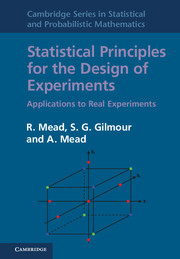Book contents
- Frontmatter
- Contents
- Preface
- Part I Overture
- 1 Introduction
- 2 Elementary ideas of blocking: the randomised complete block design
- 3 Elementary ideas of treatment structure
- 4 General principles of linear models for the analysis of experimental data
- Part II First subject
- Part III Second subject
- Part IV Coda
- References
- Index
3 - Elementary ideas of treatment structure
from Part I - Overture
Published online by Cambridge University Press: 05 November 2012
- Frontmatter
- Contents
- Preface
- Part I Overture
- 1 Introduction
- 2 Elementary ideas of blocking: the randomised complete block design
- 3 Elementary ideas of treatment structure
- 4 General principles of linear models for the analysis of experimental data
- Part II First subject
- Part III Second subject
- Part IV Coda
- References
- Index
Summary
Choice of treatments
It might seem that the choice of treatments is not a statistical matter, being a question for the experimenter alone. However, there are very many examples of research programmes where the objectives of the programme either have been, or could have been, achieved much more efficiently by using statistical theory. In some situations, there are several intuitively appealing alternative sets of treatments, and the choice between these alternatives can be assisted by a statistical assessment of the efficiency with which the alternative sets of treatments satisfy the objectives of the experiment. In other situations statistical methods can allowmore objectives to be achieved from the same set of experimental resources. In yet other situations statistical arguments can lead to adding experimental treatments which avoid the necessity of making possibly unjustifiable assumptions in the interpretation of results from the experimental data. The early theory of the design of experiments was less concerned with the choice of treatments than with the control of variation between units, but there is a large body of knowledge about treatment structure. Later, much of the statistical theory of experimental design was concerned with the optimal choice of treatments, and while some of this theory is very mathematical and some has little relevance to real experiments, the general principles are important and will be considered in Chapter 16.
The first point to clarify is that there are many different forms of objective for an experiment. Some experiments are concerned with the determination of optimal operating conditions for some chemical or biological process. Others are intended to make very precise comparisons between two or more methods of controlling or encouraging the growth of a biological organism. Some experiments are intended to provide information about the effects of increasing amounts of some stimulus on the output of the experimental units to which the stimulus is applied. And other experiments are planned to screen large numbers of possible contestants for a job, for example, drugs for treating cancer or athletes for a place in the Olympics. And most experiments have not one but several objectives.
- Type
- Chapter
- Information
- Statistical Principles for the Design of ExperimentsApplications to Real Experiments, pp. 29 - 41Publisher: Cambridge University PressPrint publication year: 2012



